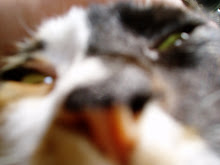Would you know what is printed on the reverse side of one thousand yen notes (or old five thousand yen notes[used from 1984 to 2007])?
If you have it now, please check it on.
You are able to see Mt.Fuji & its inverted reflection on the surface of the lake on it. The reflection is called "Sakasa Fuji 逆さ富士."
The image is made on the model of a picture which was taken at the edge of Lake Motosu 本栖湖 by KŌYŌ OKADA 岡田紅陽 (1895-1972) and is called "Kohan no Haru (Spring by the lake) 湖畔の春".
■Photos on the WEB
Mt.Fuji from Lake Motosu, on Flickr
■
EDIT : ・
BUS TIMETABLE(Fujikyū Bus) (Fuji Station / Shimobe hot springs / Motosuko - Shojiko - Kawaguchiko station - Fujikyūhighland - Fujiyoshida station) Japanese version only / The nearest bus stop to Lake Motosu is Motosu Iriguchi 本栖入口 or Motosuko 本栖湖.
・
Lake Motosu excursion boat 'MOGURAN もぐらん' (translated by Yahoo!Japan Translation Service)
■
Shiki-no-Mori Oshino Park Koyo Okada Photo Museum 四季の杜 おしの公園 岡田紅陽写真美術館 (Japanese version only)
The admission fee (only Permanent exhibition) is Adult : 500 yen / Elementary & Middle school student : 300 yen / preschool-age : charge-free (the other exhibitions : extra costs).
HOURS: 9:00-17:00 (Entry permitted up to 16:30)
CLOSED: The regular closing day is Tuesday, the day following a national holiday (except Saturday and Sunday), during the year-end and New Year holidays (December 28 to January 1) and so on. When Tuesday falls on a national holiday, the museum will be closed instead on the following day. But because these are with some exceptions, please view Closed days calendar on the above link for details (Procedure : visiting the museum ご利用案内 → 休館日カレンダー[yellow button]).
ACCESS : a) Take about 15min from Kawaguchiko I.C.[Exit] (Chūō Expressway) via National Route 138 by car
b) Take about 30min from Gotenba I.C. [Exit] (Tōmei Expressway) via National Route 138 by car
c) Take buses bound for Uchino 内野 or Hirano 平野 (via Uchino) from
Fuji Kyūkō Line Fujiyoshida Station and drop off the bus at Shiki-no-Mori Oshino Kōen bus stop. You have immediate access to the Museum from there.
d) Take buses bound for Fujiyoshida Station or Kawaguchiko Station (not via Zentana 膳棚 (Oshino Hakkai 忍野八海)) from
JR Mishima Station and drop off the bus at Oshino Iriguchi 忍野入口 bus stop. The museum is 10 minutes walk from the bus stop. But if you take buses via Zentana, drop off the bus at Shiki-no-Mori Oshino Kōen bus stop. You have immediate access to the Museum from there.
BUS TIMETABLE(Fujikyū Bus) (Japanese version only) Shiki-no-Mori Oshino Kōen bus stop is between Oshino Iriguchi and Omiyabashi お宮橋 / Zentana (Oshino Hakkai).
・
Fujiyoshida Station - Oshino Hakkai - Uchino ・
Mishima Station - Gotemba Station - (Yamanakako / Oshino Hakkai) - Fujiyoshida Station - Fujikyūhighland - Kawaguchiko station ■View
View Mt.Fuji from Lake Motosu on Google My Maps
■Reference data
新旧お札・逆さ富士の不思議 on "
地域探検!ナビィシティー" (Japanese version only)





































